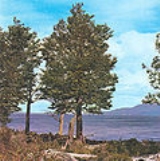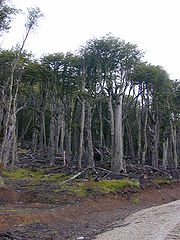
Lenga Beech
Encyclopedia
Nothofagus pumilio is a deciduous
tree
or shrub
in the Nothofagaceae family that is native to the southern Andes
range, in the temperate forests of Chile
and Argentina
to Tierra del Fuego
, from 35° to 56° South latitude. This tree is in the same genus as the Coihue
. It regenerates easily after fires. It grows well in Scotland
. The wood
has good quality, moderate durable, easy-to-work. It is used in furniture, shingles and construction and sometimes as a substitute for American Black Cherry in the manufacturing of cabinets.
it grows to a height of up to 30 m (100 ft), and attains a trunk diameter of 1.5 m (5 ft). In more northern regions it grows only at heights above 1000 meters (3300 ft) in the form of a shrub. The leaves
are dark green, elliptic toothed and 2–4 cm long, with irregularly lobed margins, and turn to yellow and reddish tones in autumn. The fruit
is a small nut
4–7 mm long.

, Tierra del Fuego National Park
, Los Alerces National Park
and Nahuel Huapi National Park
among other places. In its southerly range it occurs in dense stands as far south as Isla Navarino
. It grows in areas with low temperatures and abundant snow; therefore, in the north half of its distribution it is found only in the Andes
Range and at sea level on its southernmost natural environment. It tolerates temperatures −30 °C (−22 °F) and lower, and frosts all seasons of the year.
Deciduous
Deciduous means "falling off at maturity" or "tending to fall off", and is typically used in reference to trees or shrubs that lose their leaves seasonally, and to the shedding of other plant structures such as petals after flowering or fruit when ripe...
tree
Tree
A tree is a perennial woody plant. It is most often defined as a woody plant that has many secondary branches supported clear of the ground on a single main stem or trunk with clear apical dominance. A minimum height specification at maturity is cited by some authors, varying from 3 m to...
or shrub
Shrub
A shrub or bush is distinguished from a tree by its multiple stems and shorter height, usually under 5–6 m tall. A large number of plants may become either shrubs or trees, depending on the growing conditions they experience...
in the Nothofagaceae family that is native to the southern Andes
Andes
The Andes is the world's longest continental mountain range. It is a continual range of highlands along the western coast of South America. This range is about long, about to wide , and of an average height of about .Along its length, the Andes is split into several ranges, which are separated...
range, in the temperate forests of Chile
Chile
Chile ,officially the Republic of Chile , is a country in South America occupying a long, narrow coastal strip between the Andes mountains to the east and the Pacific Ocean to the west. It borders Peru to the north, Bolivia to the northeast, Argentina to the east, and the Drake Passage in the far...
and Argentina
Argentina
Argentina , officially the Argentine Republic , is the second largest country in South America by land area, after Brazil. It is constituted as a federation of 23 provinces and an autonomous city, Buenos Aires...
to Tierra del Fuego
Tierra del Fuego
Tierra del Fuego is an archipelago off the southernmost tip of the South American mainland, across the Strait of Magellan. The archipelago consists of a main island Isla Grande de Tierra del Fuego divided between Chile and Argentina with an area of , and a group of smaller islands including Cape...
, from 35° to 56° South latitude. This tree is in the same genus as the Coihue
Coihue
Nothofagus dombeyi is a tree species native to southern Chile and the Andean parts of Argentine Patagonia. It grows from 35 to 45° South latitude between 700 and 1,200 m above mean sea level. It forms dense forests, like those found in the Los Alerces and Nahuel Huapi national parks...
. It regenerates easily after fires. It grows well in Scotland
Scotland
Scotland is a country that is part of the United Kingdom. Occupying the northern third of the island of Great Britain, it shares a border with England to the south and is bounded by the North Sea to the east, the Atlantic Ocean to the north and west, and the North Channel and Irish Sea to the...
. The wood
Wood
Wood is a hard, fibrous tissue found in many trees. It has been used for hundreds of thousands of years for both fuel and as a construction material. It is an organic material, a natural composite of cellulose fibers embedded in a matrix of lignin which resists compression...
has good quality, moderate durable, easy-to-work. It is used in furniture, shingles and construction and sometimes as a substitute for American Black Cherry in the manufacturing of cabinets.
Description
In southern PatagoniaPatagonia
Patagonia is a region located in Argentina and Chile, integrating the southernmost section of the Andes mountains to the southwest towards the Pacific ocean and from the east of the cordillera to the valleys it follows south through Colorado River towards Carmen de Patagones in the Atlantic Ocean...
it grows to a height of up to 30 m (100 ft), and attains a trunk diameter of 1.5 m (5 ft). In more northern regions it grows only at heights above 1000 meters (3300 ft) in the form of a shrub. The leaves
Leaf
A leaf is an organ of a vascular plant, as defined in botanical terms, and in particular in plant morphology. Foliage is a mass noun that refers to leaves as a feature of plants....
are dark green, elliptic toothed and 2–4 cm long, with irregularly lobed margins, and turn to yellow and reddish tones in autumn. The fruit
Fruit
In broad terms, a fruit is a structure of a plant that contains its seeds.The term has different meanings dependent on context. In non-technical usage, such as food preparation, fruit normally means the fleshy seed-associated structures of certain plants that are sweet and edible in the raw state,...
is a small nut
Nut (fruit)
A nut is a hard-shelled fruit of some plants having an indehiscent seed. While a wide variety of dried seeds and fruits are called nuts in English, only a certain number of them are considered by biologists to be true nuts...
4–7 mm long.

Occurrence
The Lenga Beech can be found in the Torres del Paine National ParkTorres del Paine National Park
Torres del Paine National Park is a national park encompassing mountains, a glacier, a lake, and river-rich areas in southern Chilean Patagonia. The Cordillera del Paine is the centerpiece of the park. It lies in a transition area between the Magellanic subpolar forests and the Patagonian Steppes...
, Tierra del Fuego National Park
Tierra del Fuego National Park
Tierra del Fuego National Park is a national park on the Argentine part of the island of Tierra del Fuego, within Tierra del Fuego Province in the ecoregion of Patagonic Forest and Altos Andes, a part of the subantarctic forest...
, Los Alerces National Park
Los Alerces National Park
The Los Alerces National Park is a national park in Chubut Province, Argentina, some 30 miles from Esquel. It is a park of 2,630 square kilometres along the border with Chile, best known for the alerce trees from which the park takes its name.The park was created in 1937 in order to protect the...
and Nahuel Huapi National Park
Nahuel Huapi National Park
Established in 1934, the Nahuel Huapi National Park is the oldest national park in Argentina. It surrounds Nahuel Huapi Lake in the foothills of the Patagonian Andes. The largest of the national parks in the region, it has an area of , or nearly 2 million acres...
among other places. In its southerly range it occurs in dense stands as far south as Isla Navarino
Isla Navarino
Isla Navarino is a Chilean island located strategically between Isla Grande de Tierra del Fuego, to the north, and Cape Horn, to the south. The island forms part of the Commune of Cabo de Hornos, the southernmost commune in Chile and in the world, belonging to Antártica Chilena Province in the XII...
. It grows in areas with low temperatures and abundant snow; therefore, in the north half of its distribution it is found only in the Andes
Andes
The Andes is the world's longest continental mountain range. It is a continual range of highlands along the western coast of South America. This range is about long, about to wide , and of an average height of about .Along its length, the Andes is split into several ranges, which are separated...
Range and at sea level on its southernmost natural environment. It tolerates temperatures −30 °C (−22 °F) and lower, and frosts all seasons of the year.

